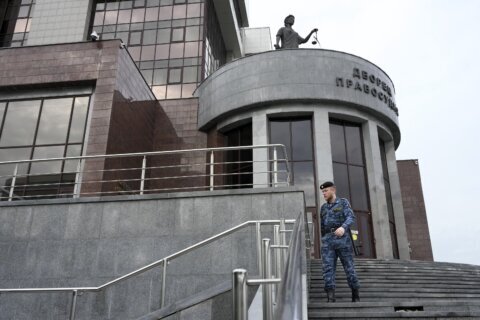NEW YORK (AP) — In a dimly lit room strung with fairy lights and ivy, transit workers file in and lie on inflated cots. Soothing piano notes play as a teacher rubs their ankles and toes.
“Breathe in,” she says. “Think of a balloon, filling up with fresh energy. Your spine dropping into softness.”
The relaxation class, held at a union hall for New York City transit employees, is one way transportation workers are managing fear and anxiety over a rise in violent crime on public transit. Concern has grown after a series of attacks against bus drivers, subway operators and station agents.
Reports of crime against transit workers have been rising since the pandemic erupted in 2020, when millions of Americans bypassed subways and buses to avoid COVID-19, leaving transit workers more isolated.
Although many riders returned, the rate of violent assaults on subways and buses remained elevated.
Nationally, the rate of reported major assaults against transit workers rose 47% from 2020 to 2023, according to an Associated Press analysis of Federal Transit Administration data.
By contrast, reports of overall violent crime in the United States have dropped every year since 2020, FBI data shows.
“We’re in the line of fire every day,” said Blanca Acosta De Avalos, a bus driver in in Omaha, Nebraska, who was severely beaten three years ago by a passenger. “We don’t have no protection.”
With transit workers trying to manage their stress over the threat of violence, some unions and transit agencies are seeking ways to reduce violence and ease anxieties.
In New York, a transit union began offering free relaxation, yoga and meditation classes, which began after a subway operator’s throat was slashed. The victim was treated at a hospital and released.
“Being a bus operator, you’re pretty much worried about everything at every moment of every day…so you don’t really get a chance to relax,” said Grace Walker, a New York City bus driver. “You’re driving a pretty big machine, and you have a lot of customers’ lives at risk.”
Walker, who attended the relaxation class, said it helped her decompress.
Transit agencies in Omaha and elsewhere are teaching de-escalation techniques to help drivers defuse potential confrontations. If a passenger makes offensive remarks, for example, the driver is coached to remain respectful and quiet. Among other steps, some unions are pushing for partitions to isolate drivers and protect them from assaults.
“My barriers are always up,” said Laticia Wright, who was driving a bus in Columbus, Ohio, last August when bullets flew through the windshield, just missing her head. “I look at people’s hands and their movements when they get on my bus.”
None of the bullets struck Wright. But broken glass did. She was so traumatized that she stayed home for three weeks and spoke daily with a counselor through an employee assistance program.
“I had to really just put it behind me,” she said.
Nearly a year after the shooting, Wright’s doctor thinks she may have post-traumatic stress disorder. “I find myself looking at every white SUV that passes by my car or my bus now,” she said. “Are they going to start shooting?”
To help relax, Wright receives chair massages offered through work. But her main coping mechanism is prayer. In tense situations, she tells herself: “OK, God. Take the wheel. Calm this situation down. Calm me down.”
Transit workers and officials largely blame lingering effects of the pandemic for the increased violence. After COVID-19 struck, many transit agencies let riders hop on for free. People struggling to stay housed rode buses for shelter. More riders overdosed on drugs.
Now, transit ridership nationally is at 75% of pre-COVID levels, according to the American Public Transportation Association.
Transit workers endure disproportionately high levels of anxiety, depression and stress-related illnesses, including heart disease and musculoskeletal disorders, according to a review of dozens of studies published in the Journal of Transport & Health.
“Sometimes it’s not just the severity of the traumatic experience — it’s the frequency, said Alexis Merdjanoff, co-investigator in a transit worker study conducted by New York University. “The verbal abuse is much more frequent, and we’re noticing that it has a really big impact on anxiety and depression and overall mental wellbeing.”
European researchers found that bus drivers, especially urban drivers, face among the highest risks of heart disease or high blood pressure of any occupational group, said Paul Landsbergis, a specialist in occupational health at State University of New York-Downstate.
In Europe, some buses include a cockpit that completely encloses the driver. So far, that’s uncommon in the U.S., leaving bus drivers feeling vulnerable.
“I’m still afraid, but I try to be strong,” said Acosta De Avalos, the driver who was beaten in Omaha. “But when somebody starts screaming, I don’t feel good. The anxiety.”
Her union is calling for harsher penalties for attacks on transit workers.
“I have a gentleman now that is deathly afraid to drive,” said Chris Nanke, who leads Transit Workers Union Local 223 in Omaha. “He has been assaulted and threatened half a dozen times.”
This spring, the Federal Transit Administration imposed stricter requirements on the safety plans transit agencies must submit to receive federal funding. The agencies must now include an equal number of frontline transit workers and management representatives on the committees that draft safety plans.
Officials in Columbus created a response team trained in mental health, addiction and de-escalation which can be dispatched to buses if a passenger becomes dangerous.
Several years ago, some transit systems installed barriers on buses. But they don’t completely enclose drivers.
New York’s transit authority is testing barriers that stretch from the floor to the roof of the bus. On subways, it’s considering adding cameras inside operator cars. Gov. Kathy Hochul deployed 1,000 officers to check bags in the subways.
“I’ve had people pull a knife out just for telling somebody, ‘Can you please turn the radio down?’” Wright said. “I just wish that there was more security for us.”
___
AP Staffers Christopher L. Keller in Albuquerque, New Mexico, and Patrick Orsagos in Columbus, Ohio, contributed to this report.
Copyright © 2024 The Associated Press. All rights reserved. This material may not be published, broadcast, written or redistributed.







